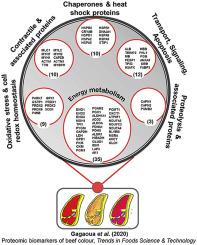Trends in Food Science & Technology ( IF 15.1 ) Pub Date : 2020-05-28 , DOI: 10.1016/j.tifs.2020.05.005 Mohammed Gagaoua , Joanne Hughes , E.M. Claudia Terlouw , Robyn D. Warner , Peter P. Purslow , José M. Lorenzo , Brigitte Picard

|
Background
Implementation of proteomics over the last decade has been an important step toward a better understanding of the complex biological systems underlying the conversion of muscle to meat. These sophisticated analytical tools have helped to reveal the biochemical pathways involved in fresh meat colour and have identified key protein biomarkers.
Scope and approach
Until recently, there have been no detailed or critical studies on the role of protein biomarkers in determining meat colour. This review presents an integromics of recent muscle proteomic studies to investigate pathways and mechanisms of beef colour. A database was created from 13 independent proteomic-based studies including data on five muscles and a list of 79 proteins which were significantly correlated with colour traits. The database was subjected to a multistep analysis including Gene Ontology annotations, pathway analysis and literature mining. This report discusses the key protein biomarkers and the biological pathways associated with fresh beef colour. Biomarkers were prioritised by the frequency of identification and the need for future validation experiments is discussed.
Key findings and conclusions
This review identifies six pathways involved in beef colour including energy metabolism, heat shock and oxidative stress, myofibril structure, signalling, proteolysis and apoptosis. The data-mining of the list of the putative biomarkers showed that certain proteins, such as β-enolase (ENO3), Peroxiredoxin 6 (PRDX6), HSP27 (HSPB1), Phosphoglucomutase 1 (PGM1), Superoxide Dismutase [Cu-Zn] (SOD1) and μ-calpain (CAPN1) were consistently reported by multiple studies as being differentially expressed and having a significant role in beef colour. This integromics work proposes a list of 27 putative biomarkers of beef colour for validation using adapted high-throughput methods.
中文翻译:

牛肉色的蛋白质组生物标志物
背景
在过去的十年中,蛋白质组学的实施是朝着更好地了解肌肉转化为肉类的基础的复杂生物系统迈出的重要一步。这些先进的分析工具有助于揭示鲜肉颜色所涉及的生化途径,并确定了关键的蛋白质生物标志物。
范围和方法
直到最近,还没有关于蛋白质生物标志物在确定肉色中作用的详细或批判性研究。这篇综述介绍了最近的肌肉蛋白质组学研究的整体学,以研究牛肉色的途径和机理。从13个基于蛋白质组学的独立研究中创建了一个数据库,其中包括5条肌肉的数据以及79种与颜色特征显着相关的蛋白质。对数据库进行了多步分析,包括基因本体论注释,途径分析和文献挖掘。本报告讨论了关键蛋白质生物标志物以及与鲜牛肉色相关的生物学途径。根据鉴定的频率对生物标记物进行优先排序,并讨论了未来验证实验的必要性。
主要发现和结论
这篇综述确定了牛肉颜色涉及的六个途径,包括能量代谢,热休克和氧化应激,肌原纤维结构,信号传导,蛋白水解和细胞凋亡。推定生物标志物列表的数据挖掘表明某些蛋白质,例如β-烯醇酶(ENO3),过氧化物酶6(PRDX6),HSP27(HSPB1),磷酸葡萄糖变酶1(PGM1),超氧化物歧化酶[Cu-Zn](多项研究一致报告SOD1和μ-钙蛋白酶(CAPN1)差异表达且在牛肉色中起重要作用。这项基因组学研究工作提出了27种公认的牛肉色生物标志物清单,以供采用改进的高通量方法进行验证。











































 京公网安备 11010802027423号
京公网安备 11010802027423号